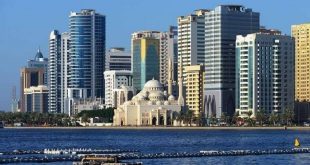Sharjah’s largest infrastructure project has taken another step towards completion following the inauguration of the Middle East’s longest covered tunnel, part of a highway development expected to boost connectivity, trade and logistics between the east and west coasts of the emirate.
On April 14 Sheikh Sultan bin Muhammad Al Qasimi, ruler of Sharjah and member of the UAE’s Supreme Council, set off the final explosive charge to blast rock from the Al Sidra Tunnel which, at 2.7 km long, is the largest of its kind in the region.
The tunnel forms part of a new 89-km road linking Sharjah City with the port city Khorfakkan, located in Sharjah’s eastern enclave. Expected to be completed next year, the new road will halve travel time between the two cities to around 45 minutes.
The Dh5.5bn ($1.5bn) project, first proposed some 14 years ago, has had a lengthy development period, with pre-construction engineering work and surveying taking two years.
Much of the difficulty was due to the rugged terrain through which the planned four-lane highway had to travel, necessitating extensive boring work. Along with the Al Sidra Tunnel, the road has four other tunnels, ranging from 300 metres to 1.4 km in length.
Road upgrades to support east coast expansion
In addition to improving connectivity, the new road network is expected to support more rapid economic development for communities along the route and on the UAE’s east coast.
With Sharjah enjoying economic growth of 5% last year, according to Invest in Sharjah, the investment promotion agency, and a doubling of foreign direct investment to $1.6bn, officials are confident the upgraded access provided by the highway will see increased economic activity flow into the Gulf of Oman coastal strip.
“Khorfakkan is going to benefit from the new road development, which will improve connections to Sharjah City and reduce travel time,” Abdullah Mohammed Al Naqbi, former chairman of Khorfakkan Municipal Council, told OBG.
In particular, the tourism sector has been highlighted as having significant growth potential. Inaugurated as part of the Sharjah-Khorfakkan Road project, the Al Rafisah Dam Recreation Centre stands as a new visitor attraction.
Located on the route and just 5 km outside of Khorfakkan, the site has a series of parks, picnic spots, play areas and parking spaces, along with a restaurant, mosque, and boating and recreation facilities on the 82,280-sq-metre lake.
The new attractions, coupled with the reduced travel time from Sharjah City and other major urban centres of the UAE, should complement Khorfakkan’s existing tourism offering, which includes a series of heritage sites, sandy beaches and coral reefs.
To meet the expected increase in tourism on Sharjah’s east coast, the authorities have invested in projects such as Khorfakkan Corniche Development, a plan to redesign 3 km of beachfront by upgrading public amenities, and developing hospitality and dining options; and the Chedi Khorfakkan, a mixed-used development with restaurants, business facilities and more than 100 accommodation suites.
Both projects fall under broader Sharjah government plans to invest Dh5bn ($1.4bn) in tourism development between 2015 and 2018.
Improved connectivity offers chance for trans-shipment growth
On top of tourism development, the improved connectivity between the UAE’s east and west coasts could also help the Port of Khorfakkan boost its standing as a trans-shipment hub.
With heavy traffic holding the potential to affect the flow of vessels through the Strait of Hormuz, identified by the US Energy Information Administration last year as the world’s most important chokepoint in terms of the volume of crude oil and petroleum products transported through it, Sharjah and other emirates have long sought alternative ways to transport goods in and out of the region.
As the UAE’s only dedicated container terminal outside of the strait, the Port of Khorfakkan benefits from cost and time advantages compared to other maritime freight hubs in the Gulf.
At present, containers unloaded at Khorfakkan generally reach domestic destinations around five days earlier than those trans-shipped through other ports in the UAE, according to Gulftainer, the private port company managing the site. The new road network is set to further improve its attractiveness in this regard, especially for companies shipping perishables or goods with tight delivery deadlines.
With six berths, 20 quay cranes, including super-post-Panamax cranes, and annual capacity of 5m twenty-foot equivalent units, the 70-ha site has the ability to handle significant flows of goods and will continue to play a key role in the increasingly competitive regional container logistics chain.






